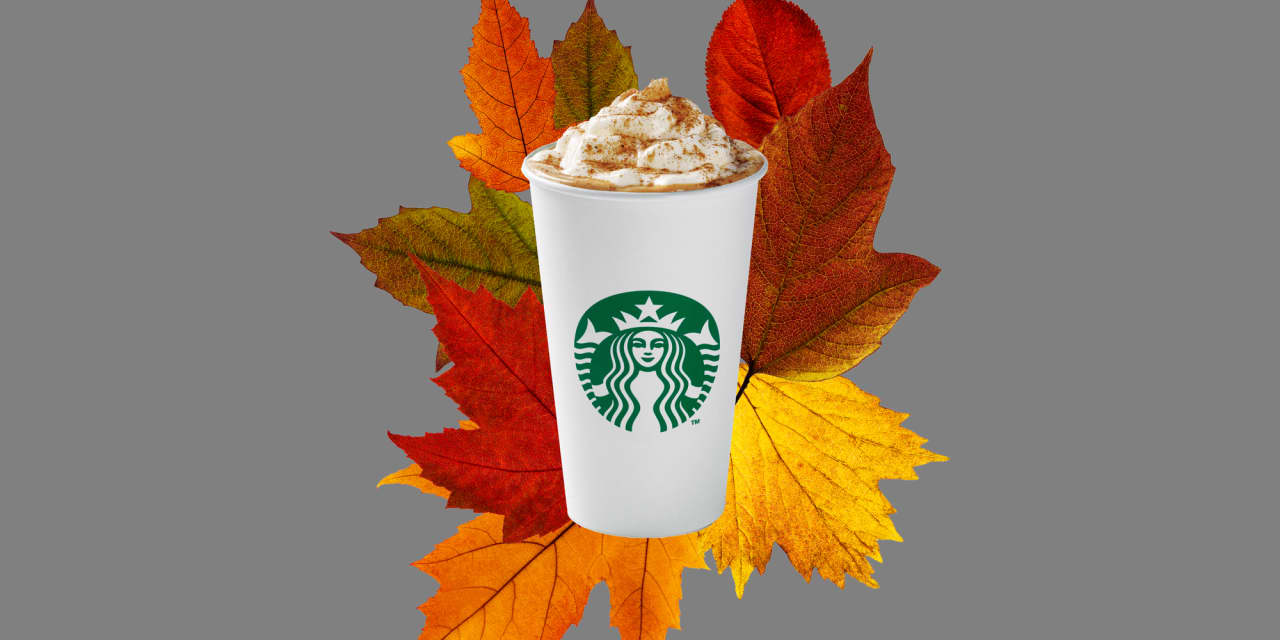Fall officially arrives Saturday, but you’d think it settled in weeks ago if you’ve picked something up at Target or T.J. Maxx—or popped into Starbucks.
The three retailers are tuned into the season, with Halloween decorations and home goods—and, of course, those pumpkin sippers.
TikTok has noticed, too, chronicling excursions to the group of stores. Users of the social media app are watching in huge numbers, which means good things for the stores—and maybe, ultimately, the stocks.
For the past 50 years, from 1972 through 2022, shares of
Target
(ticker: TGT) and
TJX
(TJX), the parent of T.J. Maxx and HomeGoods have averaged gains of 3.2% and 3.9% from August to November, according to Dow Jones Market Data. From 1992 to 2022,
Starbucks
(SBUX) has averaged a 10% increase over the same months.
Over the past four years, for the same three months, foot traffic numbers have climbed as well. Last year, compared with 2018, the number of customers coming through the doors at Target, T.J. Maxx, HomeGoods, and Starbucks increased 21.5%, 2.5%, 8.3%, and 5.9%, respectively according to location analytics platform Placer.ai.
The bump in shoppers parallels the boom in TikTok’s popularity, which started around 2019. One of this season’s trends is a white ghost-shaped pillow and collection of ghost-patterned blankets, which can be found at HomeGoods and T.J. Maxx. Dozens of videos show the throws on couches and beds—and buyers on the hunt.
With six weeks until Halloween, the hashtag “ghostblanket” already has 55.5 million views. Even shoppers who aren’t interested in the cover post about it.
“Y’all already know I could care less about these blankets, but here you go,” one TikTok user said in an Aug. 4 video, showing off a selection of pink-and-white ghost blankets at HomeGoods. The video has 33,000 likes.
For others, though, spending time in the stores isn’t about going viral.
At a HomeGoods on New York City’s Upper West Side, teens Briana Reyes and Awa Jassey—16 and 17, respectively—said they don’t visit often and had stopped in simply to browse the seasonal offerings.
“It’s always important to be seasonally relevant,” Jefferies analyst Corey Tarlowe, who rates TJX shares at Buy, told Barron’s. “But what I think is key for TJX is not so much the fact that they are always on trend, but it’s the fact that they’re getting products that not many other retailers have, at the value that they do.”
TJX told Barron’s that autumn is a favorite time for lots of shoppers.
“We know that many of our customers are thrilled to find our eclectic selection of seasonal goods both ahead of and throughout the season, including cozy fashions and home décor as well as specialty merchandise, like Halloween décor and costumes, all at everyday great values,” the company said in an email.
Target has similar thinking, according to Evercore ISI analyst Greg Melich, who rates shares at In Line.
“Part of their brand promise, historically has been ‘expect more, pay less.’ And so, you know, the reason we would rank it as one of these sort of holiday stocks, if you will, is that in consumers’ minds, it’s a time to come to Target,” Melich told Barron’s.
In a Target store in New York City, pumpkins—in orange, black, and white and in a variety of sizes—plus wreaths, dish towels and trick-or-treat baskets line the shelves.
Elva Chen, who figures she visits Target once a month, stopped by to pick up a few nonholiday items she needed.
“It’s kind of small,” said Chen, 21, referring to the store’s seasonal selection. “You don’t really see a theme.”
Target had a rough go this year, primarily because of a pullback on discretionary spending, driven by inflation. Both foot traffic and same-store sales growth have suffered.
Same-store sales growth, for example, has moved from flat to -5.4% over the last two quarters, according to
FactSet.
The drop in the most recent quarter, reported on Aug. 16, was exacerbated by nationwide backlash over the company’s collection of LGBTQ+ merchandise, which it launched in May for Pride Month, observed in June.
To bounce back, Melich recommended Target focus on merchandising.
“In retail, that is still Job One,” he said. “So buy stuff that people want, and sell it at a great price, and you’ll get traffic.”
A test of Melich’s theory is set for next month. Target is running a fall sale, called Circle Week, from Oct. 1-7.
Target didn’t respond to requests for comment.
At a Starbucks in the same New York neighborhood as Target, the menu is seasonal but not the décor.
The “pumpkin spice latte is on point,” said Laura Nagy, 27, who was vacationing in the city. She made an “OK” hand sign, but ordered a flat white, an espresso drink with steamed whole milk.
Two analysts who cover Starbucks—Cowen’s Andrew Charles and Piper Sandler’s Brian Mullan—didn’t respond to requests for comment.
Starbucks responded by directing Barron’s to its Aug. 23 news release announcing its fall drink lineup. It also pointed out that the pumpkin spice latte remains the company’s most popular seasonal beverage “with hundreds of millions sold” since its 2003 launch. “Pumpkin spice is so popular that last year the term was added to the dictionary!”
For the stocks, Target and Starbucks are down this year —19% and 3.9%, respectively—and TJX is up 14%, according to Dow Jones Market Data. For the month, Target is down 5%, Starbucks is 2.2% lower, and TJX has dropped 1.6%.
Target has been especially hard hit in these times of sticky inflation. Half of its wares are considered discretionary, which Americans simply are buying less of. Those hard-earned dollars are being spent more on household essentials—TJX, a Barron’s stock pick earlier this year, has an extensive line called Home Essentials—and food. Somewhat curiously, dining out is taking a bigger bite out of paychecks, which could explain the smaller drop for Starbucks.
Beyond higher prices is a less obvious explanation: the element of surprise. In the age of online shopping, where a product search pulls up scads of photos in seconds, part of the fun of browsing in a store is stumbling across the unexpected.
Even with seasonal merchandise, eureka discoveries are important. Those jack-o’-lantern party napkins and orange hand towels decorated with black cats are cute, most certainly, but tried and true. But a ghost blanket? Now, that’s something that shoppers can get excited about—excited enough to post a video on TikTok, in summer no less.
“Learn from my mistakes last year and grab your cute autumnal pieces early,” one user captioned a July 23 TikTok that detailed a journey to find the multicolored ghost blanket at T.J. Maxx. The video has 75,500 likes.
TJX is a master of keeping the thrill alive. Its loyal shoppers find something new each and every time, which keeps them coming back. And that sense of adventure shows up time and again on TikTok.
Starbucks is mingling mix of old and new. The Pumpkin Spice Latte is back for its 20th year. New are the Iced Pumpkin Cream Chai Tea Latte, inspired by customer and barista customizations, and the Iced Apple Crisp Oatmilk Shaken— along with a line of reusable autumn-themed mugs and tumblers. The hashtag “starbuckspsl,” however, has racked up 7 million views on TikTok, compared with the ghost blanket’s over 55 million views.
Seasonality plus surprise is a powerful equation. Starbucks, Target, and TJX have all leveraged both, over the years, with a degree of success. Today, throw TikTok into the mix and a product—a store—can catch fire.
It might be easy to dismiss the impact of social media on retail sales, especially TikTok—the U.S. government is concerned that the app, owned by Chinese company ByteDance, plays fast and loose with sensitive user data.
But think hard about it. Social media has proved over and over to be a powerful marketing tool. Lululemon’s belt bag became a must-have because of TikTok and Anheuser-Busch took a hit from a nationwide boycott of Bud Light after an Instagram endorsement by transgender influencer Dylan Mulvaney.
For the investors, the upshot: Consider the three S’s—social media, seasonality, and surprise. They could be moneymakers.
Write to Emily Dattilo at emily.dattilo@dowjones.com
Read the full article here











Leave a Reply